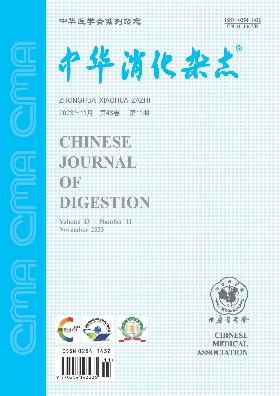Influencing factors of different bowel preparation regimens on the quality of colonoscopy
引用次数: 0
Abstract
Objective To explore the influencing factors of different bowel preparation before colonoscopy on the intestinal cleanliness and polyp detection rate. Methods From March to August in 2018, at the Center of Endoscopy of Huashan Hospital Affiliated to Fudan University, the patients who underwent colonoscopy were selected and their general data of bowel preparation regimens were collected. Self-factors of the patients, different bowel preparation regimens, bowel preparation quality and polyp detection rate were observed. The quality of bowel preparation was evaluated by Boston bowel preparation scale (BBPS). T test, and analysis of variance and chi-square test were used for statistical analysis. Results Among 1 008 patients who underwent colonoscopy, there were 506 males and 502 females, and average age was (57.3±13.7) years. There were statistically significant differences in BBPS score of patients with different body mass index (BMI), Parkinson disease and history of abdominal surgery (F=3.319, t=-2.060 and -2.544; all P<0.05). The BBPS score of patients with three-day low residue diet before examination was higher than that of those without preparation before examination (6.04±2.50 vs. 5.54±2.73), and the difference was statistically significant (t=2.514, P=0.010). The BBPS scores of 2 000 mL polyethylene glycol electrolyte lavage solution (PEG) taken once, 2 000 mL PEG taken separately, 3 000 mL PEG taken once and 3 000 mL PEG taken separately were 5.06±2.88, 6.11±2.44, 5.94±2.32 and 6.10±2.47, respectively, and the difference was statistically significant (F=7.242, P<0.01). There were significant differences in polyp detection rates among the patients with different age, gender, BMI, and with history of constipation, hypertension and diabetes mellitus (χ2=33.170, 8.489, 12.024, 4.034, 26.790, 10.381; all P<0.05). The polyp detection rate of patients with oral methyl silicone oil was higher than that of patients without oral methyl silicone oil (52.6%, 30/57 vs. 29.7%, 221/744), and the difference was statistically significant (χ2=12.934, P<0.01). Age (odds ratio (OR)=1.328, 95% confidence interval (CI) 1.162 to 1.517) and BMI (OR=1.412, 95%CI1.115 to 1.787) were independent risk factors for polyp detection rate. Conclusions Parkinson disease, history of abdominal surgery and BMI are the related factors affecting the quality of bowel preparation before colonoscopy. Age and BMI are independent risk factors for polyp detection rate. Key words: Colonoscopes; Polyethylene glycols; Bowel preparation; Simethicone不同肠准备方案对结肠镜检查质量的影响因素
目的探讨结肠镜检查前不同肠道准备对肠道清洁度及息肉检出率的影响因素。方法选择2018年3 - 8月在复旦大学附属华山医院内镜中心行结肠镜检查的患者,收集其肠道准备方案的一般资料。观察患者自身因素、不同肠准备方案、肠准备质量及息肉检出率。采用波士顿肠准备量表(Boston bowel preparation scale, BBPS)评价肠准备质量。采用T检验、方差分析和卡方检验进行统计分析。结果1 008例患者行结肠镜检查,男性506例,女性502例,平均年龄(57.3±13.7)岁。不同体重指数(BMI)、帕金森病、腹部手术史患者的BBPS评分差异有统计学意义(F=3.319, t=-2.060、-2.544;所有P < 0.05)。检查前3天低渣饮食组患者BBPS评分高于检查前未准备组(6.04±2.50∶5.54±2.73),差异有统计学意义(t=2.514, P=0.010)。2 000 mL聚乙二醇电解质灌洗液(PEG)一次取、2 000 mL单独取、3 000 mL一次取、3 000 mL单独取的BBPS评分分别为5.06±2.88、6.11±2.44、5.94±2.32、6.10±2.47,差异有统计学意义(F=7.242, P<0.01)。不同年龄、性别、BMI、有无便秘、高血压、糖尿病病史的患者息肉检出率差异有统计学意义(χ2=33.170、8.489、12.024、4.034、26.790、10.381;所有P < 0.05)。口服甲基硅油组息肉检出率高于未口服甲基硅油组(52.6%,30/57比29.7%,221/744),差异有统计学意义(χ2=12.934, P<0.01)。年龄(优势比(OR)=1.328, 95%可信区间(CI) 1.162 ~ 1.517)和BMI (OR=1.412, 95%可信区间(CI) 1.115 ~ 1.787)是影响息肉检出率的独立危险因素。结论帕金森病、腹部手术史和BMI是影响结肠镜检查前肠道准备质量的相关因素。年龄和BMI是影响息肉检出率的独立危险因素。关键词:结肠镜;聚乙二醇;肠道准备;二甲基硅油
本文章由计算机程序翻译,如有差异,请以英文原文为准。
求助全文
约1分钟内获得全文
求助全文

 求助内容:
求助内容: 应助结果提醒方式:
应助结果提醒方式:


